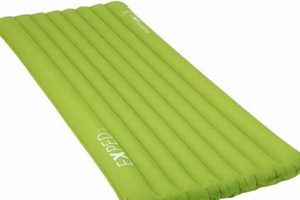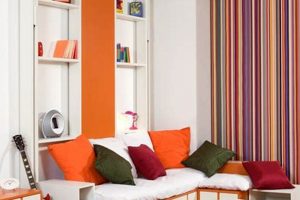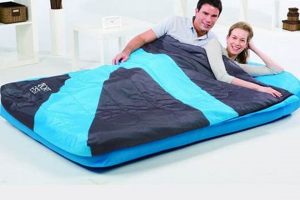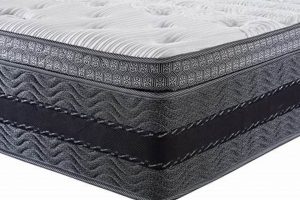This furniture option combines the functionality of a seating area with the convenience of a temporary sleeping surface. It typically consists of a convertible sofa frame that houses an inflatable sleeping pad, offering a space-saving solution for accommodating overnight guests. For example, a studio apartment dweller might utilize this dual-purpose furniture to maximize available living space while still having the capacity to host visitors.
The importance of such a design lies in its adaptability and space efficiency. Historically, pull-out sofas have been cumbersome and uncomfortable. Incorporating an inflatable sleeping surface addresses these concerns by providing a more supportive and customizable sleeping experience. The key benefit is offering a readily available guest bed without requiring a dedicated room, which is particularly valuable in smaller homes or apartments. Its portability and ease of storage when deflated further enhance its practicality.
The subsequent discussion will delve into different types and materials, advantages and disadvantages, factors to consider when selecting one, and tips for maintaining its longevity and comfort. This comprehensive overview aims to provide a clear understanding of its role as a practical and versatile furniture choice.
Optimizing the Use of Sleeper Couches with Integrated Inflatable Mattresses
The following guidelines aim to enhance the utility and lifespan of sofa beds incorporating inflatable sleeping surfaces, ensuring both comfort and durability.
Tip 1: Choose a Durable Frame. The sofa bed’s frame must withstand repeated use and conversion. Opt for frames constructed from solid hardwoods or reinforced metal to ensure long-term structural integrity.
Tip 2: Regulate Inflation Levels. Proper inflation of the air bladder is crucial. Avoid over-inflation, which can lead to seam stress and potential rupture. Conversely, under-inflation may compromise support and comfort. Consult the manufacturer’s recommendations for optimal pressure levels.
Tip 3: Employ a Protective Mattress Topper. A mattress topper serves as a barrier against abrasion and puncture. It also enhances comfort by providing an additional layer of cushioning and temperature regulation. Consider materials like memory foam or quilted cotton.
Tip 4: Ensure Proper Ventilation. After each use, allow the inflated section to air out completely before folding it back into the sofa frame. This practice minimizes moisture buildup and prevents the growth of mold or mildew.
Tip 5: Store with Care. When not in use, store the deflated section in a cool, dry place, away from direct sunlight and sharp objects. This precaution protects the material from degradation and potential damage.
Tip 6: Inspect Regularly for Leaks. Routinely examine the inflated area for signs of air leakage, such as visible punctures or a gradual decrease in firmness. Address leaks promptly with appropriate repair kits to prevent further damage and maintain functionality.
Tip 7: Follow Weight Restrictions. Adhere to the manufacturer’s specified weight limits for the inflatable sleeping area. Exceeding these limits can compromise structural integrity and lead to premature failure.
Adhering to these principles contributes significantly to the longevity, comfort, and overall value derived from sofa beds that incorporate inflatable mattresses. Consistent maintenance and careful usage practices are paramount.
The subsequent section will summarize the key advantages and disadvantages to facilitate informed purchasing decisions.
1. Space Optimization
Space optimization is a primary driver in the adoption of convertible furniture, particularly sofa beds utilizing inflatable sleeping surfaces. In urban environments and smaller residences, maximizing usable area is a crucial consideration. This furniture category addresses that need by consolidating seating and sleeping functions into a single unit.
- Dual Functionality and Footprint Reduction
The core principle of space optimization lies in the item’s dual functionality. During the day, it serves as a standard sofa, occupying a defined area for seating. At night, it converts into a bed, expanding its footprint. However, this expansion is temporary and readily reversible, allowing for efficient use of the same square footage for different purposes at different times. Examples include studio apartments or home offices, where a dedicated guest room is impractical.
- Vertical Space Preservation
Unlike traditional beds, a sofa bed with an inflatable surface primarily utilizes horizontal space. This is beneficial because it avoids the obstruction of vertical space, allowing for the placement of shelves, cabinets, or other storage solutions above the unit. This aspect is particularly relevant in rooms with limited floor area and high ceilings, maximizing the overall storage capacity of the room.
- Storage Integration
Certain designs incorporate built-in storage compartments within the sofa frame. These compartments can be used to store bedding, pillows, or other items related to guest accommodation. This further reduces clutter and minimizes the need for separate storage units, enhancing the overall organization and spaciousness of the living area.
- Adaptability to Multipurpose Rooms
The convertible nature of the sofa bed makes it ideally suited for multipurpose rooms, such as living rooms that double as guest rooms, or home offices that occasionally serve as sleeping quarters. This flexibility allows residents to adapt their living space to changing needs without the need for extensive renovations or additional furniture purchases.
The benefits of space optimization with this type of furniture extend beyond mere square footage conservation. It promotes a more organized and efficient living environment, particularly in constrained spaces. By consolidating functions, utilizing vertical space, and integrating storage solutions, this furniture choice contributes to a more functional and comfortable living experience.
2. Guest accommodation
The provision of guest accommodation is a core function directly addressed by sofa beds featuring integrated inflatable mattresses. The causal relationship is evident: the need for temporary sleeping arrangements for visitors directly leads to the consideration of space-saving solutions like these convertible furnishings. The importance of guest accommodation as a component of this type of furniture is paramount; without this inherent purpose, the unit’s primary utility diminishes. For example, a homeowner expecting relatives for an extended stay may opt for this type of sofa bed as a means of providing a comfortable sleeping space without dedicating an entire room for that purpose. The understanding of this link is practically significant because it informs purchasing decisions, emphasizing the selection of a model that prioritizes comfort and durability in its inflatable sleeping surface.
Further analysis reveals that the selection of a particular model depends heavily on the anticipated frequency and duration of guest stays. Infrequent overnight visits may only necessitate a basic model, while longer stays warrant investment in a higher-quality option with enhanced support and features, such as adjustable inflation settings or integrated headrests. Another practical application lies in emergency situations where temporary housing is required. A sofa bed of this type provides a readily available sleeping surface in the event of unforeseen circumstances, such as home repairs or displacement due to inclement weather. This adaptability is key in ensuring comfort and security for temporary occupants. The dimensions also influence the decision; a full sized sleeper sofa with air mattress that can sleep two or three guests may be preferred for large families or groups. A smaller version may be preferred for individual guests to conserve space.
In summary, the provision of guest accommodation is inextricably linked to the utility and value proposition of sofa beds with integrated inflatable mattresses. Understanding this connection allows for informed purchasing decisions tailored to specific needs and usage scenarios. Challenges arise in balancing space efficiency with comfort and durability, but careful consideration of these factors results in a practical and versatile solution for temporary sleeping arrangements. This aligns with the broader theme of optimizing living spaces and accommodating diverse lifestyle needs within a compact footprint.
3. Comfort level
The comfort level afforded by a sleeper couch incorporating an air mattress is a paramount consideration, directly influencing user satisfaction and the perceived value of the product. A direct causal relationship exists: diminished comfort results in decreased utility and a negative user experience. The importance of comfort as a component is amplified by the inherent purpose; if the product fails to provide adequate rest, its functionality is compromised. For example, a homeowner purchasing a sleeper couch for occasional guest use will likely prioritize models with superior comfort features to ensure a positive experience for visitors. This emphasizes the selection of models incorporating adjustable inflation mechanisms and higher-quality mattress materials.
Further analysis reveals that the perception of comfort is subjective and dependent on individual preferences and physical needs. Factors such as mattress firmness, support distribution, and temperature regulation contribute significantly to the overall comfort level. For instance, users with back pain may require a firmer mattress with enhanced lumbar support, while others may prefer a softer, more conforming surface. Practical applications include using mattress toppers of varying materials, such as memory foam or quilted cotton, to customize the feel of the sleeping surface. The use of fitted sheets and mattress protectors also contributes to hygiene and enhanced tactile comfort. In addition, some high-end models integrate features like zoned support, which adjusts the firmness level in different areas of the mattress to accommodate varying body weights and sleeping positions.
In summary, achieving an acceptable comfort level is crucial to the success of any sleeper couch utilizing an air mattress. This requires careful consideration of mattress materials, inflation settings, and user-specific needs. While challenges remain in replicating the comfort of a traditional bed, advancements in design and materials are continually improving the user experience. This aligns with a broader trend of prioritizing comfort and ergonomic design in home furnishings, reflecting a growing awareness of the impact of sleep quality on overall health and well-being.
4. Portability
Portability, in the context of sofa beds incorporating inflatable mattresses, refers to the relative ease with which the furniture can be moved or transported. A causal relationship exists: the inherent design characteristics directly influence its degree of portability. The importance of portability stems from its ability to address diverse needs such as relocation, temporary housing arrangements, or simply the rearrangement of living spaces. For instance, individuals in temporary living situations, such as students or renters, often prioritize furniture options that can be easily disassembled and transported. This emphasizes the selection of models that feature lightweight materials, modular construction, and compact storage capabilities when deflated.
Further analysis reveals that portability is not solely determined by weight. Dimensions, packaging, and the presence of integrated handles or wheels also play a significant role. Practical applications include the use of dedicated carrying bags to protect the inflatable mattress during transport and to facilitate easier handling. The modular design of certain models allows for disassembly into smaller, more manageable components. Furthermore, the inflatable nature of the mattress itself contributes to portability; when deflated, it occupies significantly less volume than a traditional mattress. The consideration of doorways, stairwells, and vehicle cargo space is crucial when evaluating the overall portability of a sofa bed.
In summary, the portability of a sofa bed with an inflatable mattress is a complex attribute determined by multiple factors. While not all models prioritize portability to the same degree, the ability to easily move or transport the furniture enhances its versatility and value. Challenges arise in balancing portability with comfort and durability, but innovative designs continue to address these competing needs. The increasing demand for flexible and adaptable living spaces underscores the growing importance of portability in furniture selection.
5. Cost effectiveness
Cost effectiveness, when evaluating a sleeper couch with an air mattress, transcends the initial purchase price. It encompasses a broader analysis of value, considering factors such as longevity, utility, and the avoidance of alternative expenditures. This examination seeks to determine if the benefits justify the investment, especially when compared to other furniture and bedding options.
- Initial Investment vs. Long-Term Value
The initial cost of a sleeper couch with an air mattress may be lower than that of a traditional sofa and separate guest bed. However, the lifespan of the inflatable component influences long-term cost effectiveness. Frequent replacements of the air mattress due to wear and tear can negate initial savings. Therefore, models with durable construction and readily available replacement parts contribute to better long-term value.
- Space Saving and Dual Functionality
The dual functionality of a sleeper couch eliminates the need for a dedicated guest room, freeing up valuable space in smaller homes or apartments. This space saving translates to cost savings, as it avoids the need for larger living spaces or additional storage solutions. The ability to convert seamlessly between seating and sleeping arrangements enhances its utility, further contributing to its cost effectiveness.
- Maintenance and Repair Costs
While the initial purchase price may be appealing, ongoing maintenance and repair costs can impact the overall cost effectiveness. Air mattresses are susceptible to punctures and leaks, requiring periodic repairs or replacements. The availability and cost of repair kits and replacement mattresses should be considered when evaluating the long-term financial implications of this type of furniture.
- Comparison to Alternative Solutions
To accurately assess cost effectiveness, it is essential to compare the sleeper couch with an air mattress to alternative solutions, such as traditional sofa beds, futons, or inflatable beds used separately. Each option has its own set of costs and benefits, including purchase price, durability, comfort, and space requirements. A thorough comparison allows for a more informed decision based on individual needs and budgetary constraints.
In conclusion, the cost effectiveness of a sleeper couch with an air mattress is a multifaceted consideration that extends beyond the initial purchase price. It requires a comprehensive analysis of long-term value, space saving benefits, maintenance costs, and a comparison to alternative solutions. By carefully weighing these factors, consumers can determine if this type of furniture represents a sound investment that aligns with their needs and financial resources.
6. Ease of use
The operational simplicity of a sleeper couch with an air mattress directly influences its desirability and practicality. A discernible cause-and-effect relationship exists: complex setup or takedown procedures diminish user satisfaction and impede frequent utilization. Ease of use, therefore, functions as a crucial component, affecting not only initial acceptance but also sustained adoption. For instance, a potential purchaser with limited mobility or time constraints would likely prioritize a model that requires minimal physical exertion and setup time. This underscores the importance of intuitive design and straightforward operational mechanisms.
Further analysis reveals that ease of use encompasses several sub-elements: inflation and deflation processes, conversion mechanisms between sofa and bed configurations, and storage considerations. Practical applications include the incorporation of electric pumps for rapid inflation and deflation, as well as lightweight frame materials that facilitate effortless conversion. The inclusion of clear, concise instructions and intuitive labeling further enhances user experience. Models featuring automated conversion systems, such as push-button operation, represent a higher level of operational simplicity. In contrast, designs necessitating manual manipulation of heavy components or complex folding procedures detract from overall usability.
In summary, the operational simplicity of a sleeper couch with an air mattress is a critical factor governing its practical value and user acceptance. While achieving complete automation and effortless operation may present design challenges, prioritizing user-friendly features is essential. This focus aligns with the broader trend of simplifying everyday tasks through intuitive design, ultimately enhancing the convenience and appeal of convertible furniture.
7. Maintenance requirements
The durability and lifespan of a sleeper couch with an air mattress are directly contingent upon consistent and appropriate maintenance. A neglect of maintenance protocols precipitates premature degradation and functional impairment. The importance of maintenance arises from the inherent materials and construction, both of which are susceptible to damage from environmental factors, usage patterns, and accidental occurrences. For instance, the inflatable component is vulnerable to punctures and leaks, while the sofa frame can suffer from structural stress and upholstery wear. Proper maintenance mitigates these risks and ensures prolonged usability. Neglecting the frame with the air mattress will likely cause the frame to be unusable. This may cause injury when in use, especially when used by guests.
Further examination of maintenance requirements reveals a multifaceted approach encompassing cleaning, inspection, and preventative measures. Regular cleaning of the upholstery and frame prevents the accumulation of dirt and allergens. Periodic inspection of the air mattress for leaks or structural weaknesses allows for timely repairs. Preventative measures, such as using a mattress protector and adhering to weight restrictions, minimize the risk of damage. Practical applications include the use of mild detergents for stain removal, patching kits for minor air leaks, and periodic tightening of screws or bolts on the sofa frame. The maintenance schedule should be adapted to usage frequency, with more frequent attention required for heavily used units.
In summary, adherence to a consistent maintenance schedule is crucial for maximizing the lifespan and utility of a sleeper couch with an air mattress. While maintenance procedures may require time and effort, the benefits in terms of prolonged functionality and cost savings are substantial. Challenges exist in educating users about proper maintenance techniques, but the long-term value of doing so cannot be overstated. This reinforces the broader theme of responsible furniture ownership and the proactive management of household resources.
Frequently Asked Questions About Sleeper Couches with Air Mattresses
The following questions address common concerns and provide informative answers regarding sleeper couches incorporating inflatable sleeping surfaces. These responses aim to clarify key aspects and dispel misconceptions.
Question 1: What is the expected lifespan of the integrated air mattress?
The longevity of the inflatable sleeping surface varies depending on the quality of materials, frequency of use, and adherence to maintenance protocols. Generally, a lifespan of 3 to 5 years can be anticipated with proper care. Regular inspection for leaks and adherence to weight restrictions are crucial factors.
Question 2: Can the air mattress be replaced if it becomes damaged?
Replacement options depend on the manufacturer and specific model. Some manufacturers offer replacement air mattresses as separate components. If a replacement is unavailable, generic air mattresses of appropriate dimensions may be considered, although fit and compatibility cannot be guaranteed.
Question 3: What is the recommended weight limit for the sleeping surface?
The weight limit is determined by the sofa bed’s frame and the air mattress’s construction. This specification is typically indicated on a label attached to the product or within the user manual. Exceeding the stated weight limit can compromise the structural integrity of the frame and potentially damage the air mattress.
Question 4: How is the air mattress inflated and deflated?
Inflation and deflation are typically facilitated by an integrated electric pump or a manual air pump. Electric pumps offer rapid inflation and deflation with minimal physical exertion. Manual pumps require manual operation to inflate and deflate the sleeping surface. Specific procedures are outlined in the user manual.
Question 5: What type of bedding is recommended for use on the inflatable mattress?
Standard fitted sheets and blankets designed for mattresses of comparable dimensions are suitable. The use of a mattress protector is strongly recommended to safeguard against spills, stains, and wear. Avoid using excessively heavy bedding, as it may place undue stress on the air mattress.
Question 6: How should the sleeper couch be cleaned and maintained?
Regular cleaning of the upholstery with a vacuum cleaner or damp cloth is recommended. Avoid using harsh chemicals or abrasive cleaners. The air mattress should be inspected periodically for leaks and cleaned with a mild soap and water solution. Consult the manufacturer’s guidelines for specific maintenance instructions.
In summation, understanding these common concerns facilitates informed decision-making and promotes responsible product ownership. Prioritizing quality, adhering to usage guidelines, and implementing proper maintenance practices are essential for maximizing the value and lifespan of sleeper couches incorporating air mattresses.
The subsequent section provides a comparative analysis of different models currently available on the market.
Sleeper Couch with Air Mattress
The preceding analysis has explored the multifaceted nature of the sleeper couch with air mattress. From its space-saving benefits and guest accommodation capabilities to considerations of comfort, portability, cost-effectiveness, ease of use, and essential maintenance, a comprehensive understanding has been established. The inherent duality of this furniture category presents both advantages and challenges, necessitating careful evaluation prior to purchase.
Ultimately, the value of a sleeper couch with air mattress lies in its ability to provide a practical and adaptable solution for diverse living spaces. Prospective buyers are encouraged to weigh the discussed factors against their specific needs and priorities, ensuring informed decisions that align with long-term satisfaction and responsible resource management. Future advancements in materials and design may further enhance the comfort and durability of this furniture option, solidifying its place as a versatile element in modern homes.





![Best Semi Truck Sleeper Mattress [Guide + Reviews] Organic & Natural Mattress Buyer’s Guide: Non-Toxic Sleep Solutions Best Semi Truck Sleeper Mattress [Guide + Reviews] | Organic & Natural Mattress Buyer’s Guide: Non-Toxic Sleep Solutions](https://mattressworldpa.com/wp-content/uploads/2025/07/th-1748-300x200.jpg)

